Assessment of Depressional Wetland Degradation, Spatial Distribution, and Geological Aspects in Southern Brazil
Abstract
1. Introduction
2. Study Area
3. Materials and Methods
3.1. Depressional Wetland Conceptual Model
3.2. Collection of Previous Data and Development of Maps of the Environmental Components
3.3. Identification, Delineation, and Characterization of Depressional Wetlands and Catchment Areas
3.4. Analysis of Regional Intermediate Groundwater Flow
3.5. Wetland Classification
3.6. Assessment of Potential Function Significance
3.7. Anthropogenic Interferences and Environmental Problems
4. Results
4.1. Inventory and Basic Characteristics of the Wetlands and Catchment Areas
4.2. Soil Characterization of Wetlands and Catchment Area
- Combination 1—Wetlands associated with diabase and residual unconsolidated material
- Combination 2—Wetlands associated with transported unconsolidated material composed of clay colluvium overlying the diabase
- Combination 3—Wetlands associated with residual unconsolidated materials from the Corumbataí, Irati, and Tatuí Formations
- Combination 4—Wetlands associated with transported unconsolidated material consisting of sandy colluvium deposited on the residual materials
- Combination 5—Wetlands associated with unconsolidated materials in alluvial deposits
4.3. Hydrological Aspects of Wetlands
4.4. Rainfall and Water Level Monitoring
4.5. Wetland Classification
4.6. Significance of Wetland Potential Functions
4.7. Land Use, Anthropogenic Interference, and Surface Area of Ponded Water
5. Discussion
5.1. General Comments
5.2. Wetland Characterization and Function Significance
5.3. Wetland Degradation
6. Conclusions
Author Contributions
Funding
Conflicts of Interest
References
- Winter, T.C.; LaBaugh, J.W. Hydrologic considerations in defining isolated wetlands. Wetlands 2003, 23, 532–540. [Google Scholar] [CrossRef]
- Johnson, W.C.; Boettcher, S.E.; Poiani, K.A.; Guntenspergen, G.R. Influence of weather extremes on the water levels of glaciated prairie wetlands. Wetlands 2004, 24, 385–398. [Google Scholar] [CrossRef]
- Bates, B.C.; Kundzewicz, Z.W.; Wu, S.; Palutikof, J.P. (Eds.) Climate Change and Water. Technical Paper of the Intergovernmental Panel on Climate Change, IPCC Secretariat, Geneva. 2008. Available online: http://www.ipcc.ch/publications_and_ata/publications_and_data_technical_papers_climate_change_and_water.htm (accessed on 17 May 2018).
- Poff, L.; Brinson, M.; Day, J.R.J. Aquatic Ecosystems & Global Climate Change: Potential Impacts on Inland Freshwater and Coastal Wetland Ecosystems in the United States; Pew Center on Global Climate Change: Washington, DC, USA, 2002. [Google Scholar]
- Winter, T.C. The vulnerability of wetlands to climate change: A hydrologic landscape perspective. J. Am. Water Resour. Assoc. 2000, 36, 305–311. [Google Scholar] [CrossRef]
- Hayashi, M.; Van der Kamp, G.; Rosenberry, D. Hydrology of Prairie Wetlands: Understanding the Integrated Surface-Water and Groundwater Processes. Wetlands 2016, 237–254. [Google Scholar] [CrossRef]
- Luo, H.R.; Smith, L.M.; Allen, B.L.; Haukos, D.A. Effects of sedimentation on playa wetland volume. Ecol. Appl. 1997, 7, 247–252. [Google Scholar] [CrossRef]
- Reiss, K.C.; Brown, M.T. Evaluation of Florida Palustrine Wetlands: Application of USEPA Levels 1, 2, and 3 Assessment Methods. EcoHealth 2007, 4, 206–218. [Google Scholar] [CrossRef]
- Moreno-Mateos, D.; Power, M.E.; Comín, F.A.; Yockteng, R. Structural and functional loss in restored wetland ecosystems. PLoS Biol. 2012, 10. [Google Scholar] [CrossRef]
- Evenson, G.R.; Golden, H.E.; Lane, C.R.; McLaughlin, D.L.; D’Amico, E. Depressional wetlands affect watershed hydrological, biogeochemical, and ecological functions. Ecol. Appl. 2018, 28, 953–966. [Google Scholar] [CrossRef]
- Gallaway, S.; Davis, C.; Dvorett, D.; Tramell, B. Validation of the Oklahoma Rapid Assessment Method (OKRAM) in Depressional Wetlands Using EPA’S Three-Tiered Framework. Wetlands 2019, 1–13. [Google Scholar] [CrossRef]
- Reinelt, L.; Horner, R.; Azous, A. Impacts of urbanization on palustrine (depressional freshwater) wetlands—Research and management in the Puget Sound region. Urban Ecosyst. 1998, 2, 219–236. [Google Scholar] [CrossRef]
- Skagen, S.K.; Melcher, C.P.; Haukos, D.A. Reducing sedimentation of depressional wetlands in agricultural landscapes. Wetlands 2008, 28, 594–604. [Google Scholar] [CrossRef]
- Mccauley, L.; Anteau, M.; Van der Burg, M.; Wiltermuth, M. Land use and wetland drainage affect water levelsand dynamics of remaining wetlands. Ecosphere 2015, 6, 1–22. [Google Scholar] [CrossRef]
- Riato, L.; Bella, V.; Leira, M.; Taylor, J.; Oberholster, P. A diatom functional-based approach to assess changing environmental conditions in temporary depressional wetlands. Ecol. Indic. 2017, 78, 205–213. [Google Scholar] [CrossRef]
- Ficken, C.; Cobbaert, D.; Rooney, R. Low extent but high impact of human land use on wetland flora across the boreal oil sands region. Sci. Total Environ. 2019, 693. [Google Scholar] [CrossRef] [PubMed]
- Johnston, C.A. Wetland Losses Due to Row Crop Expansion in the Dakota Prairie Pothole Region. Wetlands 2013, 33, 175–182. [Google Scholar] [CrossRef]
- Finlayson, C. Loss and Degradation of Australian Wetlands. In LAWASIA Conference: Environmental Law Issues in the Asia-Pacific Region; Supervising Scientist: Darwin, Australia, 2000. [Google Scholar]
- Ballantine, K.; Schneider, R. Fifty-five years of soil development in restored freshwater depressional wetlands. Ecol. Appl. 2009, 19. [Google Scholar] [CrossRef]
- Wu, Q.; Lane, C.R. Delineating wetland catchments and modeling hydrologic connectivity using lidar data and aerial imagery. Hydrol. Earth Syst. Sci. 2017, 21, 3579–3595. [Google Scholar] [CrossRef]
- Neff, B.P.; Rosenberry, D.O.; Leibowitz, S.G.; Mushet, D.M.; Golden, H.E.; Rains, M.C.; Brooks, J.R.; Lane, C.R. A Hydrologic Landscapes Perspective on Groundwater Connectivity of Depressional Wetlands. Water 2020, 12, 50. [Google Scholar] [CrossRef]
- Macedo-Soares, P.H.M.; Petry, A.C.; Farjalla, V.F.; Caramaschi, E.P. Hydrological connectivity in coastal inland systems: Lessons from a Neotropical fish metacommunity. Ecol. Freshw. Fish. 2010, 19, 7–18. [Google Scholar] [CrossRef]
- Moraes, A.B.; Stenert, C.; Rolon, A.S.; Maltchik, L. Effects of landscape factors and hydroperiod on aquatic macroinvertebrates with different dispersal strategies in southern Brazil ponds. J. Freshw. Ecol. 2014, 29, 319–335. [Google Scholar] [CrossRef]
- Alho, C.; Mamede, S.; Benites, M.; Andrade, B.; Sepúlveda, J. Threats to the biodiversity of the Brazilian Pantanal due to land use and occupation. Ambient. Soc. 2019, 22. [Google Scholar] [CrossRef]
- Cunha, C.; Junk, W. Identificação e Análise das Ameaças e Impactos no Componente Pantanal e recomendações para salvaguardá-lo. Wetl. Int. Blue Corridor Rep. 2019, 1, 1–79. [Google Scholar]
- Parizotto, T. Morphological and Hydrochemical Study of Small Depressions in Nhecolândia, Pantanal. Master’s Thesis, Geography, University of São Paulo, São Paulo, Brazil, 2012. [Google Scholar]
- Almeida, F. Distribution and Correlation of Soil Physical and Chemical Parameters in Cerrado Wetland Applying Mathematical Models. Ph.D. Thesis, University of Uberlândia, Uberlândia, Brazil, 2016. [Google Scholar]
- Furlan, L. Hidrodinâmica em Área Úmida de Cerrado na Chapada Sedimentar do Oeste Mineiro. Master’s Thesis, Universidade Estadual Paulista, Rio Claro-Brazil, Brazil, 2019. [Google Scholar]
- Caldarelli, C.E.; Gilio, G. Expansion of the sugarcane industry and its effects on land use in São Paulo: Analysis from 2000 through 2015. Land Use Policy 2018, 76, 264–274. [Google Scholar] [CrossRef]
- EPA. Elements of a State Water Monitoring and Assessment Program for Wetlands. 2006. Available online: http://www.epa.gov/owow/wetlands/pdf/Wetland_Elements_Final.pdf (accessed on 25 June 2017).
- Ratter, J.A.; Ribeiro, J.F.; Bridgewater, S. The Brazilian cerrado vegetation and threats to its biodiversity. Ann. Bot. 1997, 80, 223–230. [Google Scholar] [CrossRef]
- Lollo, J.A. Mapeamento Geotécnico da Folha de Leme—SP. Master’s Thesis, University of São Paulo, São Carlos, Brazil, 1991. [Google Scholar]
- Marcuzzo, F.; Arantes, E.; Wendland, E. Evaluation of potential and direct evapotranspiration estimate methods applied in the region of São Carlos. Irriga Botucatu 2008, 13, 323–338. [Google Scholar] [CrossRef]
- Acreman, M.C.; Felicity, M. Hydrological Impact Assessment of Wetlands. In Proceedings of the ISGWAS Conference on Groundwater Sustainability, Alicante, Brazil, 24–27 January 2006; pp. 225–255. [Google Scholar]
- IBGE (Instituto Brasileiro de Geografia e Estatística). Cartas topográficas, Folha:SF-23-Y-A-II-1 (LEME) Escala1:50.000. 1971. Available online: https://www.ibge.gov.br/geociencias/downloads-geociencias.html (accessed on 25 October 2018).
- EMBRAPA, Levantamento Pedológico Semi-Detalhado do Estado de São Paulo, 1:100.000 scale. EMBRAPA Brasília. 1981. Available online: https://www.ibge.gov.br/geociencias/downloads-geociencias.html (accessed on 25 October 2018).
- ANA (Brazilian National Water Agency). Rainfall Data. 2015. Available online: http://www.snirh.gov.br/hidrotelemetria/Default.html (accessed on 29 March 2018).
- NASA. Landsat Data Continuity Mission: Continuously Observing Your World. Available online: http://ldcm.gsfc.nasa.gov/mission_details.html (accessed on 5 July 2019).
- GOOGLE. Google Earth Satellite Images. 2019. Available online: https://earth.google.com/web/data=CiQSIhIgOGQ2YmFjYjU2ZDIzMTFlOThiNTM2YjMzNGRiYmRhYTA (accessed on 11 November 2019).
- Base. Aerophotogametry and Projects. 1971. Available online: https://www.baseaerofoto.com.br/ (accessed on 13 April 2019).
- Zuquette, L.V.; Pejon, O.J.; Collares, J.Q.S. Engineering geological mapping developed in the Fortaleza Metropolitan Region, State of Ceara, Brazil. Eng. Geol. 2004, 71, 227–253. [Google Scholar] [CrossRef]
- Zuquette, L.V. Mapeamento Geotécnico Preliminar na Região de São Carlos. Master’s Thesis, University of São Paulo, São Carlos-Brazil, Brazil, 1981. [Google Scholar]
- ABNT. NBR 6508: Solo, Determinação da Massa Específica Aparente; ABNT: Rio de Janeiro, Brazil, 1984; p. 8. [Google Scholar]
- ABNT. NBR 6502: Rochas e Solos—Análise Granulométrica Conjunta; ABNT: Rio de Janeiro, Brazil, 1995; p. 18. [Google Scholar]
- IBGE. Manual Técnico de Pedologia, 2nd ed.; IBGE: Rio de Janeiro, Brazil, 2007; ISBN 978-85-240-3722-9.
- Tukey, J.W. The Problem of Multiple Comparisons. In The Collected Works of John W. Tukey VIII; Multiple Comparisons: 1948–1983 1–300; Chapman and Hall: New York, NY, USA, 1953. [Google Scholar]
- Kruskal, W.H.; Wallis, W.A. Use of Ranks in One-Criterion Variance Analysis. J. Am. Stat. Assoc. 1952, 47, 583–621. [Google Scholar] [CrossRef]
- Brinson, M.M. A Hydrogeomorphic Classification for Wetlands; Wetlands Research Program Tech. Rep. WRP-DE-4; U.S. Army Engineer Waterways Expt. Station: Vicksburg, MS, USA, 1993.
- Mitsch, W.M.; Gosselink, J.G. Wetlands, 4th ed.; John Wiley and Sons, Inc.: Somerset, NJ, USA, 2007; p. 582. [Google Scholar]
- Smith, D.R.; Ammann, A.; Bartoldus, C.; Brinson, M.M. An Approach for Assessing Wetland Functions Using Hydrogeomorphic Classification, Reference Wetlands, and Functional Indices; Wetlands Research Program Technical Report WRP-DE-9; US Army Corps of Engineers, Waterways Experiment Station: Vicksburg, MS, USA, 1995.
- Sutter, L.A.; Stanfill, J.B.; Haupt, D.M.; Bruce, C.; Wuenscher, J.E. North Carolina Coastal Region Evaluation of Wetland Significance. A Report of the Strategic Plan for Improving Coastal Management in North Carolina; Department of Environment and Natural Resources, North Carolina Division of Coastal Management: Morehead City, NC, USA, 1999.
- USDA. Textural Classification Soil Survey Staff. Soil Taxonomy: A Basic System of Soil Classification for Making and Interpreting Soil Surveys; Soil Conservation Service, U.S. Department of Agriculture Handbook 436; USDA: Washington, DC, USA, 1975.
- Winter, T.C.; Rosenberry, D.O. The interaction of ground water with prairie pothole wetlands in the Cottonwood Lake Area, east-central North Dakota, 1979–1990. Wetlands 1995, 15, 193–211. [Google Scholar] [CrossRef]
- Sharratt, B. Groundwater recharge during spring thaw in the Prairie Pothole Region of North America. Int. J. Water 2009, 5. [Google Scholar] [CrossRef]
- Gurdak, J.J.; Roe, C.D. Review: Recharge rates and chemistry beneath playas of the High Plains aquifer, USA. Hydrogeol. J. 2010, 18, 1747–1772. [Google Scholar] [CrossRef]
- Failache, M.; Zuquette, L. Geological and geotechnical land zoning for potential Hortonian overland flow in a basin in southern Brazil. Eng. Geol. 2018, 246, 107–122. [Google Scholar] [CrossRef]
- Van der Kamp, G.; Hayashi, M. Groundwater-wetland ecosystem interaction in the semiarid glaciated plains of North America. Hydrogeol. J. 2009, 17, 203–214. [Google Scholar] [CrossRef]
- Zuquette, L.; Palma, J.; Pejon, O. Initial Assessment of the Infiltration and overland flow for different rainfall events in land constituted of sandstones of the Botucatu Formation (Guarani Aquifer), State of São Paulo, Brazil. Environ. Geol. 2006, 50, 371–387. [Google Scholar] [CrossRef]
- Ramberg, L.; Wolski, P.; Krah, M. Water balance and infiltration in a seasonal floodplain in the Okavango Delta, Botswana. Wetlands 2006, 26, 677–690. [Google Scholar] [CrossRef]
- Freitas, J.G.; Furquim, S.A.C.; Aravena, R.; Cardoso, E.L. Interaction between lakes’ surface water and groundwater in the Pantanal wetland, Brazil. Environ. Earth Sci. 2019, 78, 139. [Google Scholar] [CrossRef]
- Fetter, C.W. Applied Hydrogeology, 4th ed.; Prentice-Hall, Inc.: Upper Saddle River, NJ, USA, 2001; p. 598. [Google Scholar]
- Assine, M.L.; Merino, E.R.; Pupim, F.N.; Warren, L.V.; Guerreiro, R.L.; McGlue, M.M. Geology and Geomorphology of the Pantanal Basin; Bergier, I., Assine, M., Eds.; Dynamics of the Pantanal Wetland in South American, Springer International Publisher: Berlin/Heidelberg, Germany, 2016. [Google Scholar]
- LaBaugh, J.W.; Winter, T.C.; Rosenberry, D.O. Hydrologic functions of prairie wetlands. Great Plains Res. 1998, 8, 17–37. [Google Scholar]
- Van der Kamp, G.; Hayashi, M. The groundwater recharge function of small wetlands in the semi-arid Northern Prairies. Great Plains Res. 1998, 8, 39–56. [Google Scholar]
- Christofoletti, C.A.; Escher, J.P.; Correia, J.E.; Marinho, J.F.U.; Fontanetti, C.S. Sugarcane vinasse: Environmental implications of its use. Waste Manag. 2013, 33, 2752–2761. [Google Scholar] [CrossRef]
- Jiang, Z.-P.; Li, Y.-R.; Wei, G.-P.; Liao, Q.; Su, T.-M.; Meng, Y.-C.; Zhang, H.; Lu, C. Effect of long-term vinasse application on physico-chemical properties of sugarcane field soils. Sugar Technol. 2012, 14, 412–417. [Google Scholar] [CrossRef]
- Silva, M.; Griebeler, N.; Borges, L. Uso de vinhaça e impactos nas propriedades do solo e lençol freático. Revista Brasileira de Engenharia Agrícola e Ambiental 2007, 11, 108–114. [Google Scholar] [CrossRef]
- Ehsanzadeh, E.; van der Kamp, G.; Spence, C. On the changes in long-term streamflow regimes in the north American prairies. Hydrol. Sci. J. 2016, 61, 64–78. [Google Scholar] [CrossRef]
- Huang, S.; Young, C.; Feng, M.; Heidemann, K.; Cushing, M.; Mushet, D.M.; Liu, S. Demonstration of a conceptual model for using LiDAR to improve the estimation of floodwater mitigation potential of Prairie Pothole Region wetlands. J. Hydrol. 2011, 405, 417–426. [Google Scholar] [CrossRef]
- Shuldiner, P.; Cope, F. Ecological effects of highway fills on wetlands: Examples from the field. Transp. Res. Board 1979, 736, 29–37. [Google Scholar]
- Reinelt, L.; Horner, R. Pollutant removal from stormwater runoff by palustrine wetlands based on a comprehensive budget. Ecol. Eng. 1995, 4, 77–97. [Google Scholar] [CrossRef]
- Azous, A.L. An Analysis of Urbanization Effects on Wetland Biological Communities. Master’s Thesis, Department of Civil Engineering, University of Washington, Seattle, WA, USA, 1991. [Google Scholar]
- US Environmental Protection Agency. Natural Wetlands and Urban Stormwater: Potential Impacts and Management, 843-R-001; Office of Water, US Environmental Protection Agency: Washington, DC, USA, 1993.
- Skagen, S.K.; Burris, L.E.; Granfors, D.A. Sediment Accumulation in Prairie Wetlands under a Changing Climate: The Relative Roles of Landscape and Precipitation. Wetlands 2016, 36, 383–395. [Google Scholar] [CrossRef]
- Chmielewski, R.M. Hydrologic Analysis of Carolina Bay Wetlands at the Savannah River Site, South Carolina. Master’s Thesis, University of Wisconsin-Milwaukee, Milwaukee, WI, USA, 1996. [Google Scholar]
- Kirkman, L.K.; Goebel, P.C.; West, L.; Drew, M.; Palik, B. Depressional wetland vegetation types: A question of plant community development. Wetlands 2000, 20, 373–385. [Google Scholar] [CrossRef]

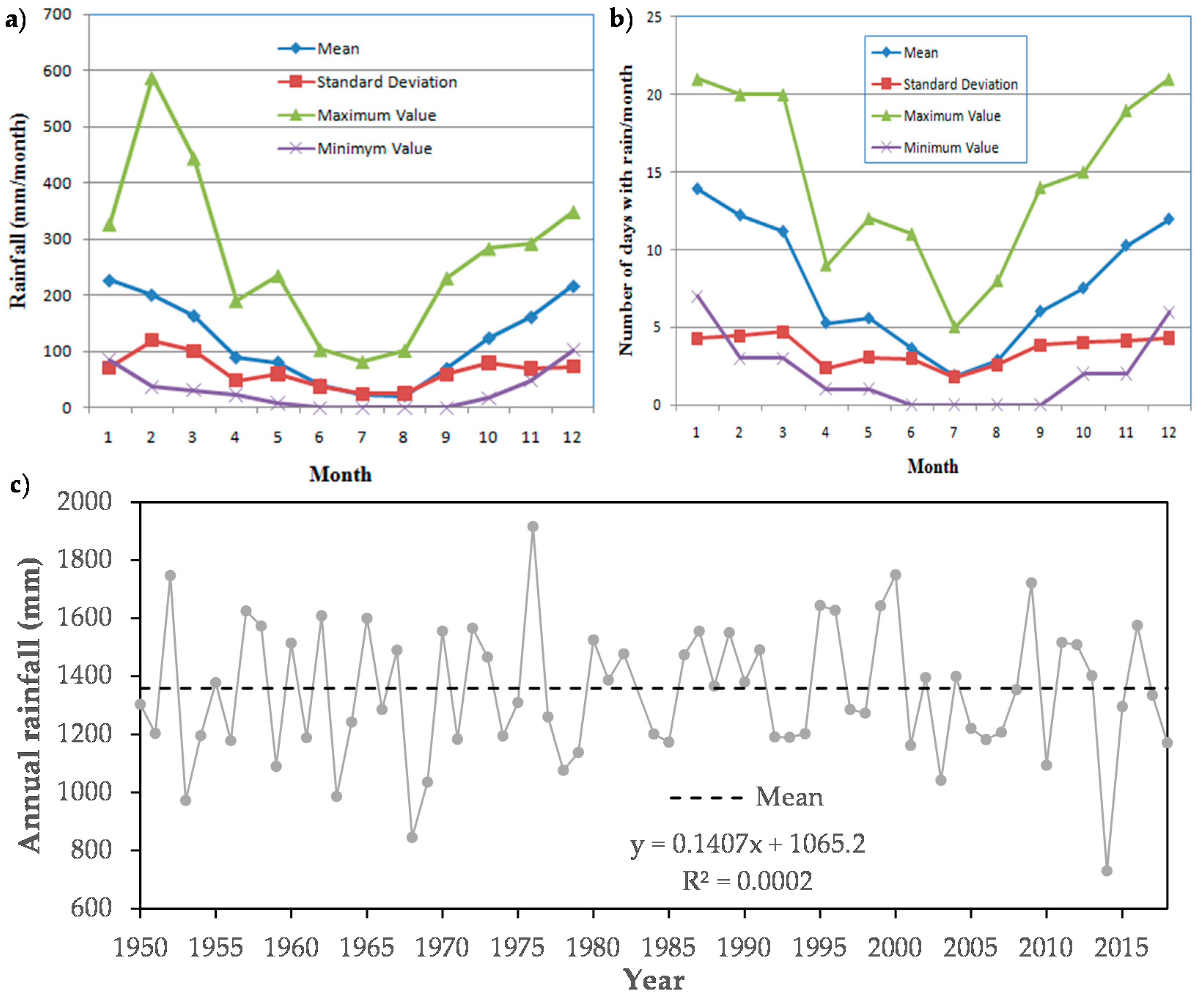
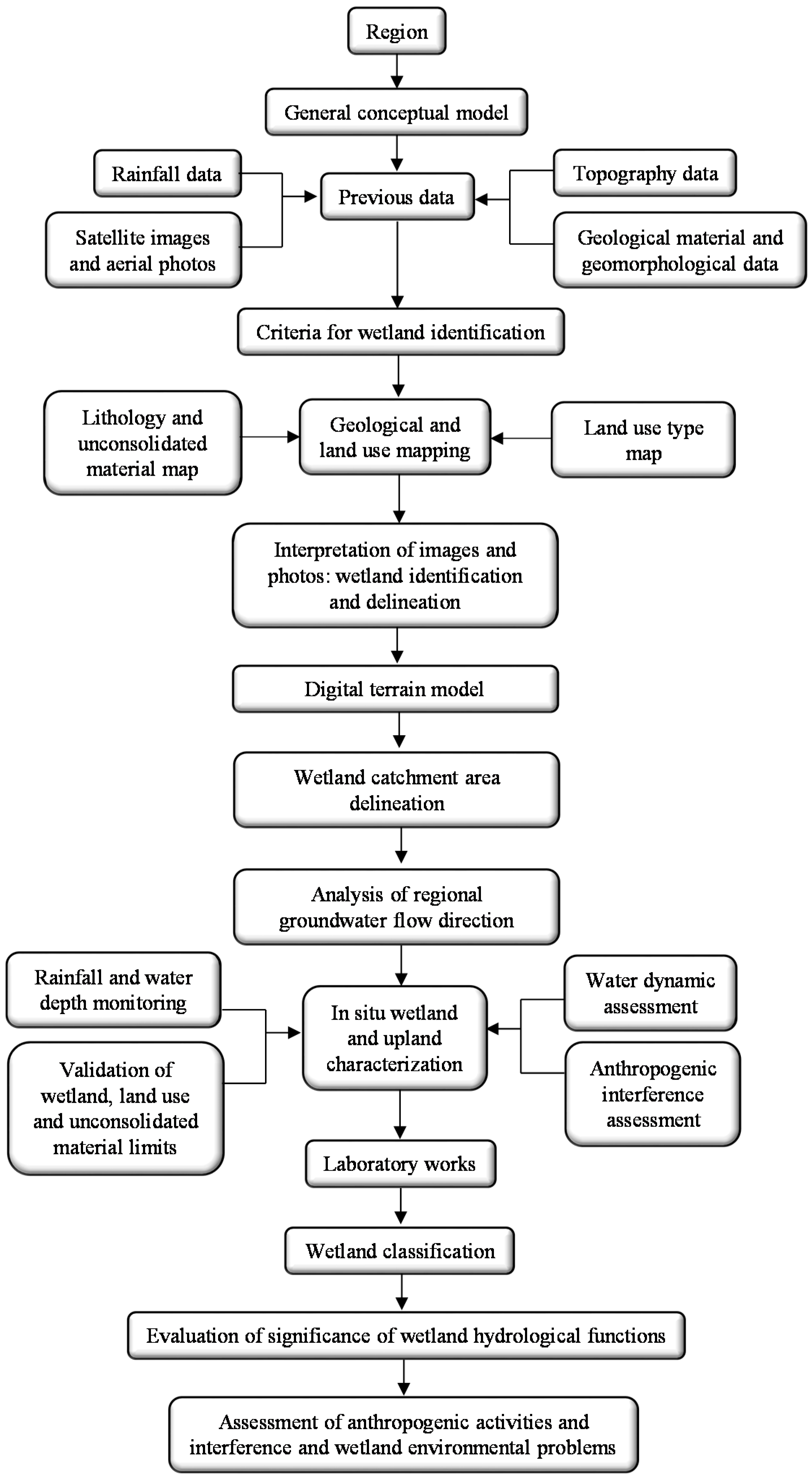
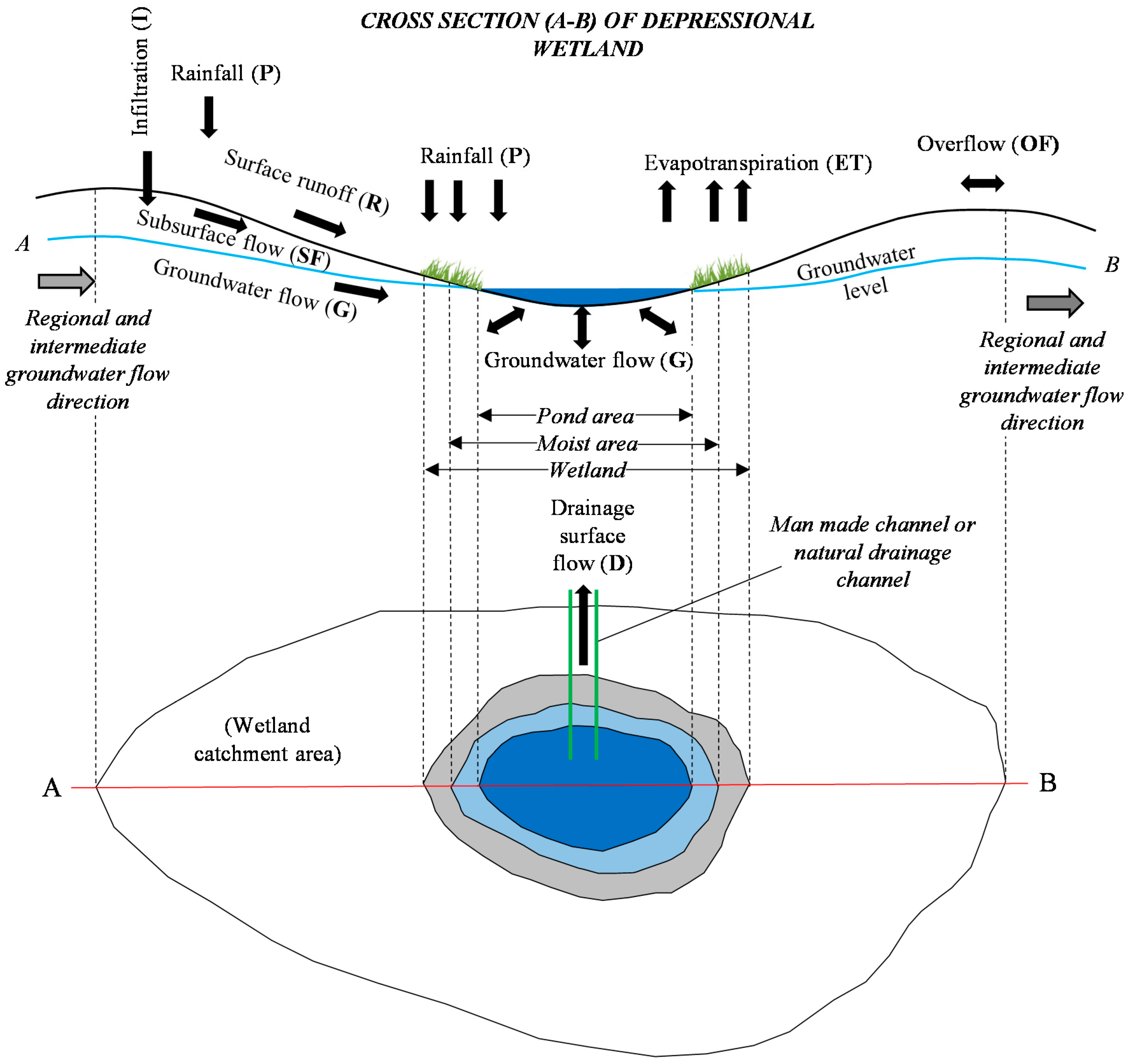
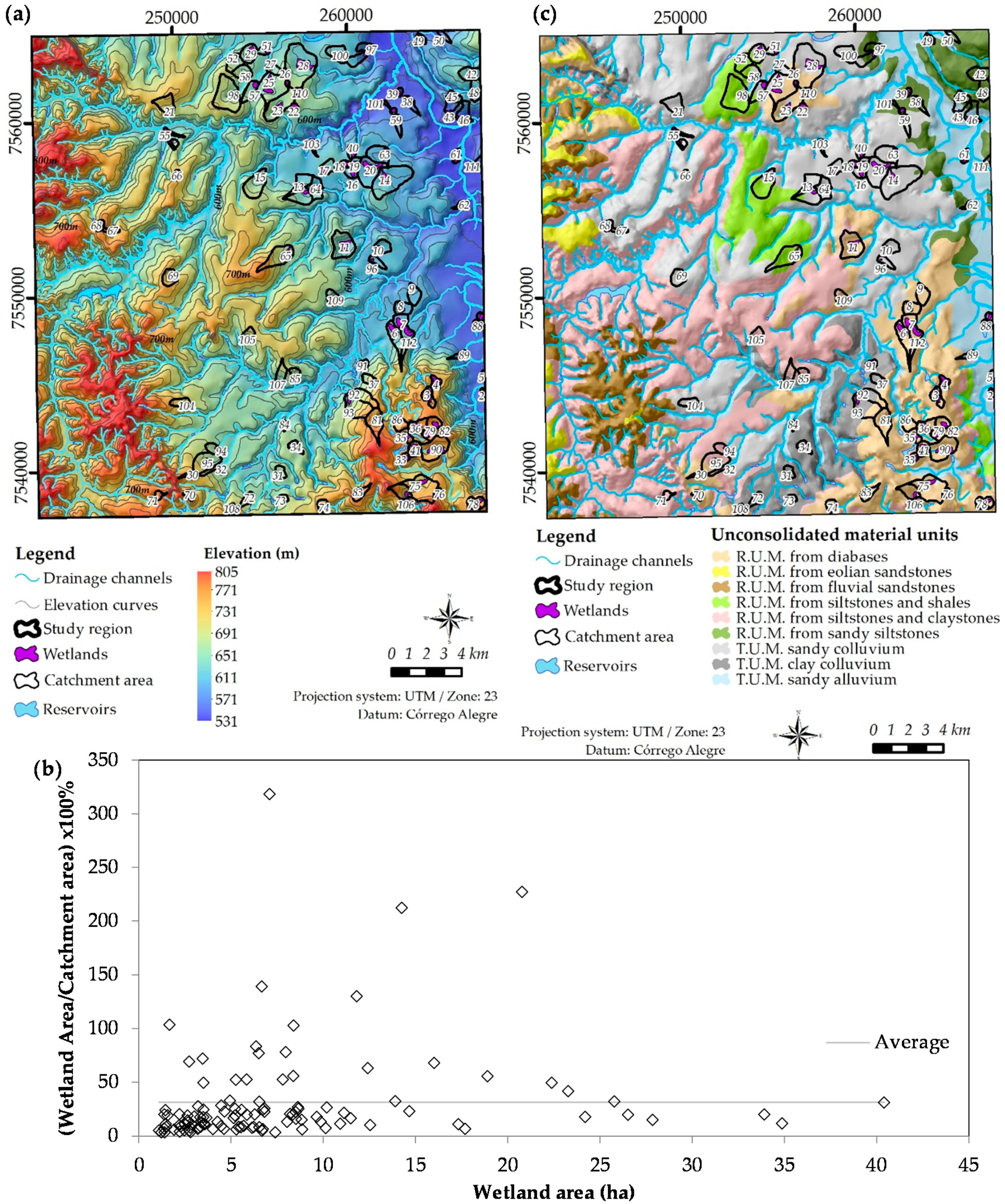
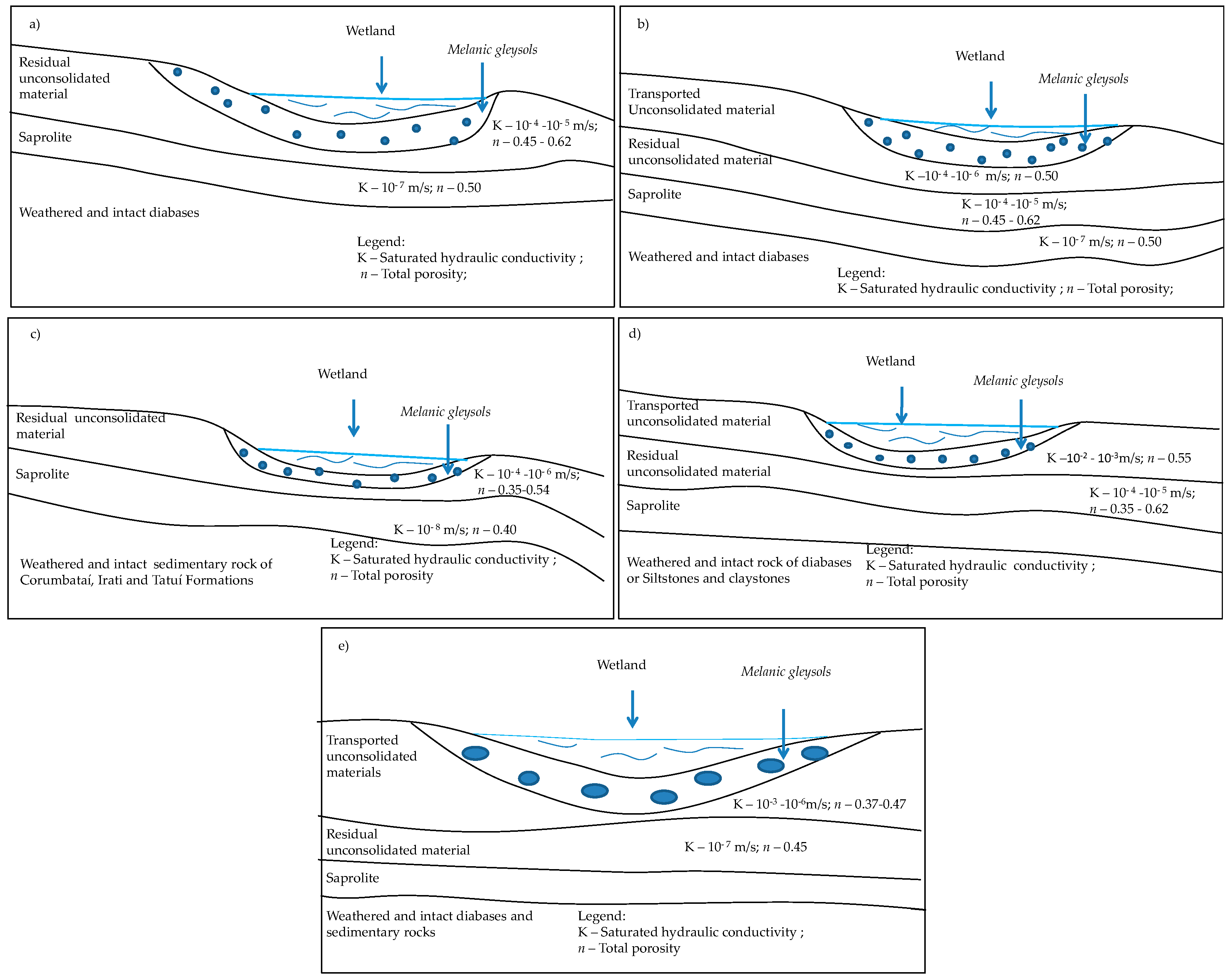
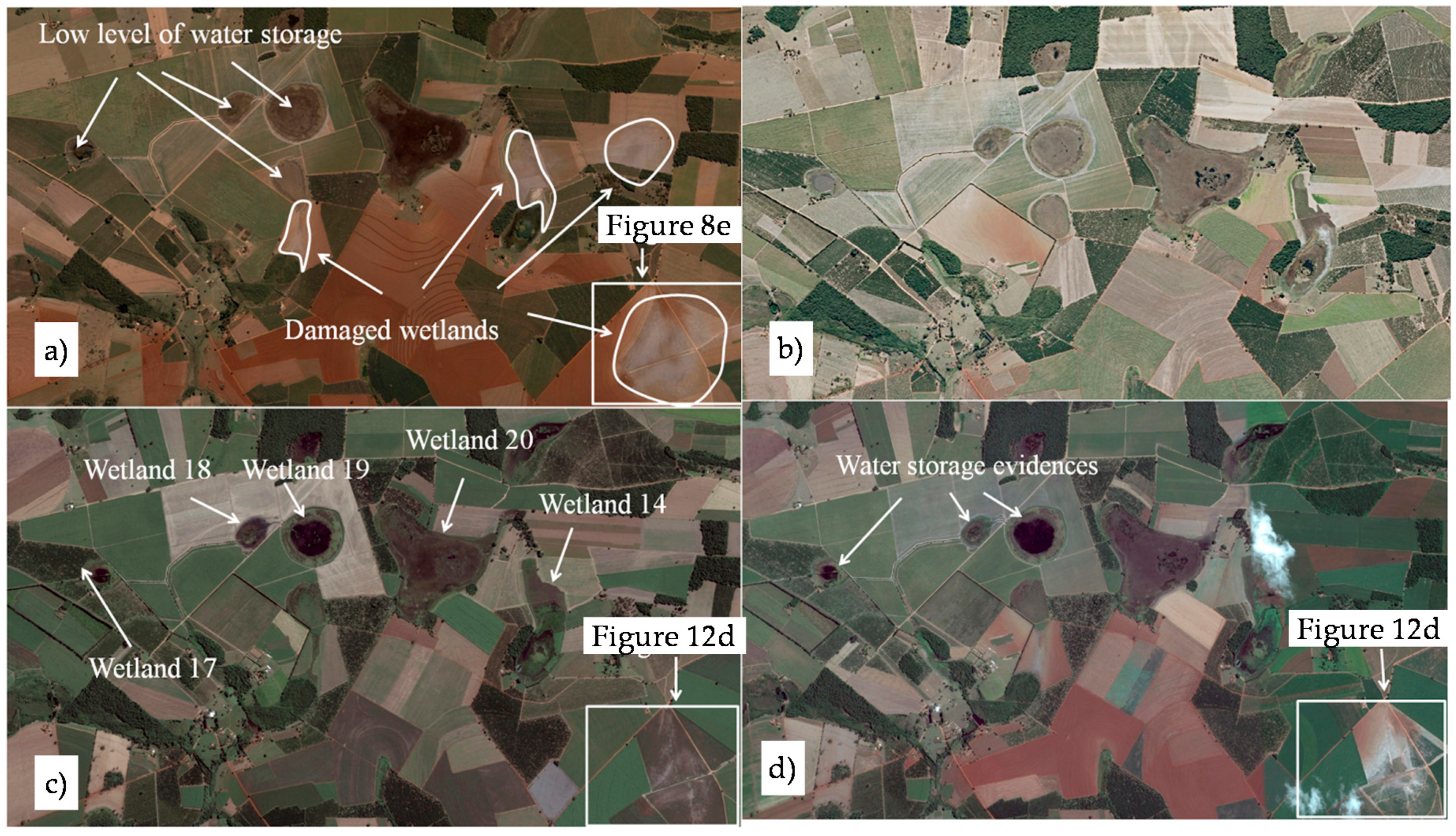
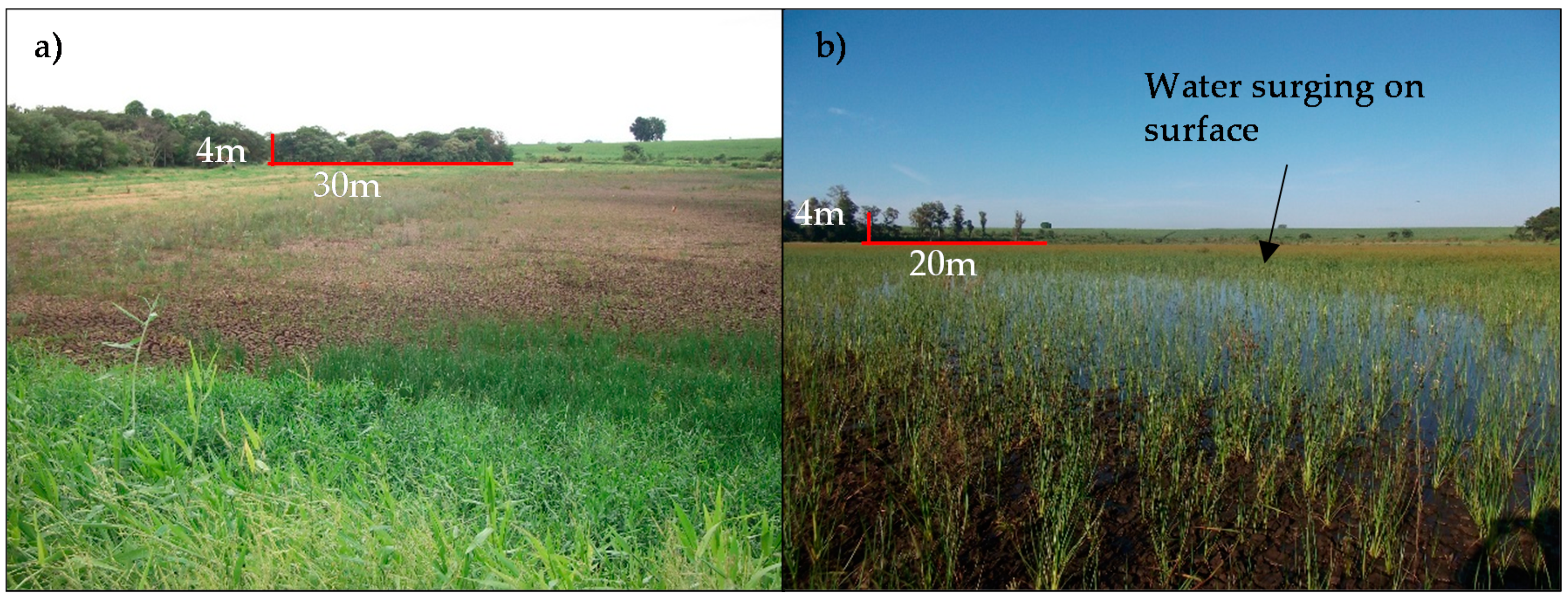

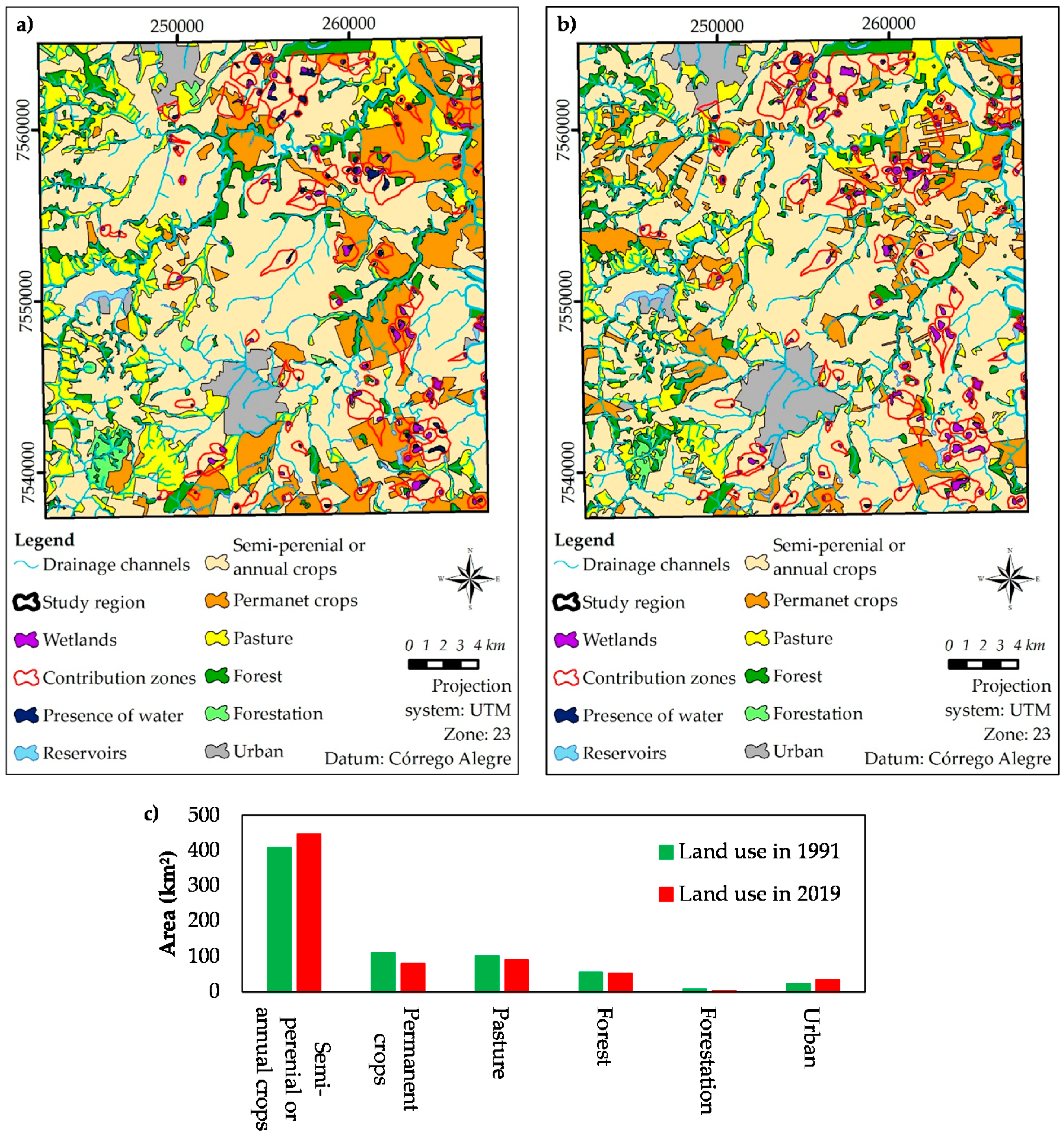
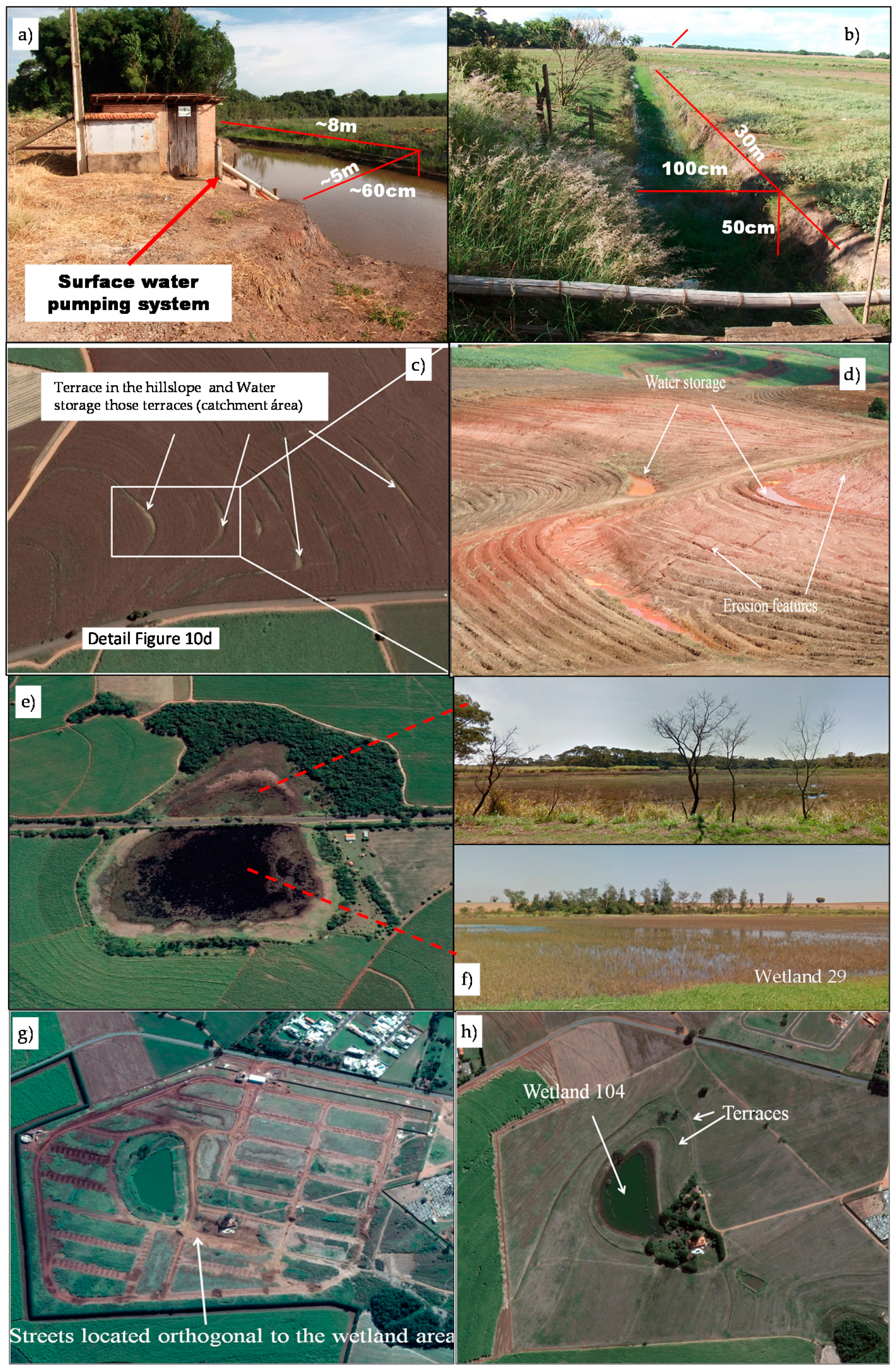
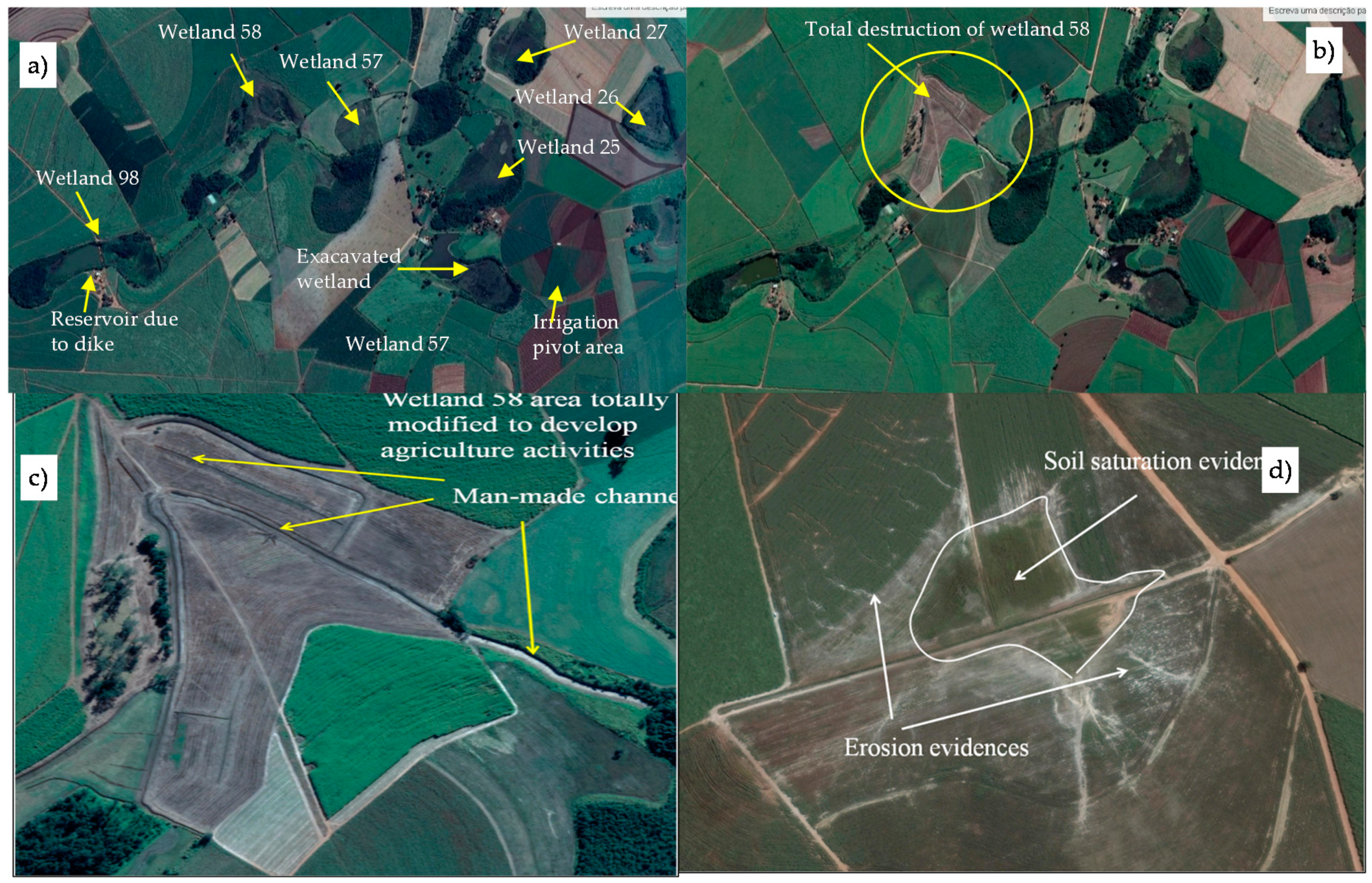
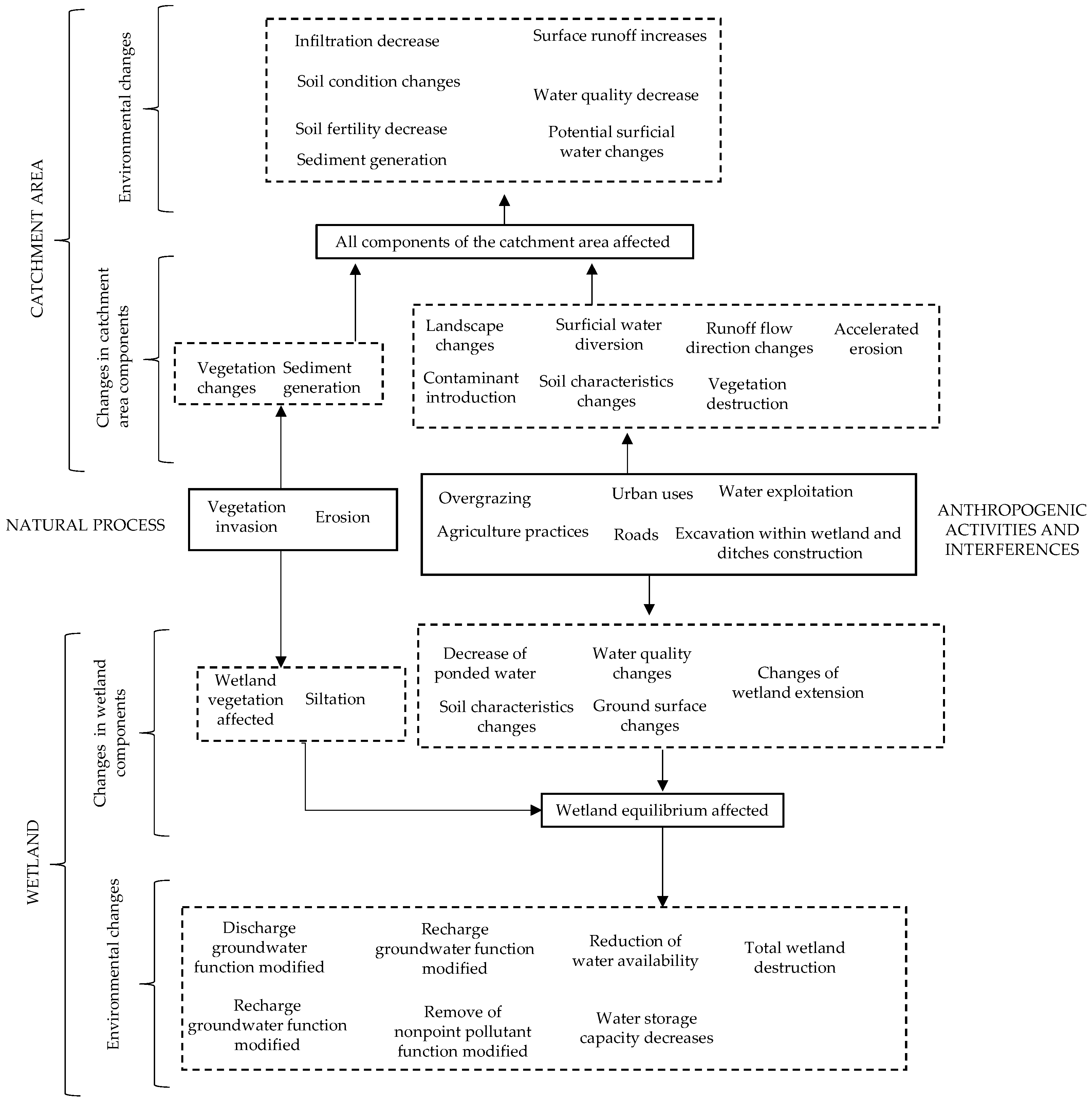
| Environmental Components | Product | Source | Scale or Resolution |
|---|---|---|---|
| Relief and drainage channels | Topographic map | [35] | 1:50,000 |
| Lithologies units | Bedrock map | [32] | 1:50,000 |
| Unconsolidated material units | Map unconsolidated materials | [32] | 1:50,000 |
| Landform unit | Landform map | [32] | 1:50,000 |
| Geotechnical characterization of unconsolidated material units | Basic characterization of unconsolidated materials | [32] [36] | - |
| Annual, monthly and daily rainfall and rainfall events | Rainfall records | [37] | 0.5 mm |
| Wetlands; Land use types | Satellite images | [38] | 30 m |
| [39] | 10–30 m | ||
| Wetlands | Aerial photos | [40] | 1:35,000 |
| Function | Function | Parameter | Explanation |
|---|---|---|---|
| Water quality | Nonpoint source pollution removal | Proximity to sources | More of the perimeter of the wetland surrounded by agricultural and urban land uses, the higher the probability that polluted runoff entering the wetland |
| Proximity to water body | If there are water bodies near to wetland, smaller will be the probability that polluted runoff entering the wetland because it can enter directly in surface water. | ||
| Wetland soil characteristic | Finer the texture and the higher the organic matter content of the soil, the higher its cation exchange capacity is and the more effective it is in retaining and transforming nutrients. | ||
| Hydrology | Surface runoff Storage | Watershed position | The further upstream in a watershed, the greater is the impact of water storage on overall watershed hydrology. |
| Wetland size | The larger wetland size, greater will be the water storage. | ||
| Catchment area | The larger catchment area, greater will be the probability to generate higher volumes of runoff | ||
| Saturated hydraulic conductivity | The hydraulic conductivity determines the amount of water that soil can receive and store, and be available as surface runoff. | ||
| Groundwater discharge and recharge | Saturated hydraulic conductivity | The hydraulic conductivity determines the amount of infiltrated water. Higher hydraulic conductivity greater will be the groundwater recharge potential in catchment area, which will rise groundwater level increasing the possibility to groundwater discharge in wetland. | |
| Catchment area | The larger catchment area, greater will be the volume of infiltration and potential local groundwater recharge that increase the possibility of higher groundwater discharge volumes in wetland. | ||
| occurrence of throughflow | Identification of occurrence of throughflow that moves nearly parallel to the soil surface until a certain point that returns to the surface becoming or not overland flow, thus reducing the volume of groundwater recharge. | ||
| Wetland area | Greater the wetland area, greater will be the groundwater recharge in wetland. |
| Unconsolidated Material | Area (km2) | Texture a | Thickness (m) | Soil Total Porosity | Hydraulic Conductivity (cm/s) |
|---|---|---|---|---|---|
| R.U.M. from Diabases | 107.2 | Clay to Sandy clay | <10 | 0.45–0.62 | 10−4–10−5 |
| R.U.M. from Eolian sandstones | 16.7 | Sand to Loamy Sandy | <2 | 0.41–0.48 | >10−3–10−4 |
| R.U.M. from fluvial sandstones | 39.5 | Sandy loam to Sandy clay loam | <5 | 0.41 | 10−3–10−4 |
| R.U.M. of siltstones and claystones | 173.3 | Clay | <5 | 0.35–0.48 | 10−4–10−6 |
| R.U.M. siltstones and shale | 32.4 | Clay to Sandy clay | <5 | 0.50–0.54 | 10−4–10−6 |
| R.U.M. from sandy siltstones | 28.4 | Sandy clay loam | <5 | 0.40 | 10−4–10−5 |
| T.U.M. sandy colluvium | 162.7 | Loamy sand to Sandy loam | <10 | 0.37–0.44 | 10−2–10−3 |
| T.U.M. clay colluvium | 47.2 | Clay | <5 | 0.50 | <10−4–10−6 |
| T.U.M. sandy alluvium | 96.8 | Sandy loam | <2 | 0.37–0.47 | 10−3–10−6 |
| Hydromorphic soil (Melanic Gleysol) | 9.0 | Sandy clay loam to Clay | <2 | 0.45–0.60 | 10−6 |
| Hydrological Condition | Dry Season | Rainy Season |
|---|---|---|
| Water storage in man-made drainage channels and excavation holes that water level is below wetland surface | 5 | 6 |
| Ponded water in wetlands | 11 | 8 |
| Soil saturation evidences. | 2 | - |
| Dry conditions | 17 | 8 |
| Increase of ponded water depth | * | 9 |
| Water storage increase in man-made drainage channels and excavated and augering holes | * | 4 |
© 2020 by the authors. Licensee MDPI, Basel, Switzerland. This article is an open access article distributed under the terms and conditions of the Creative Commons Attribution (CC BY) license (http://creativecommons.org/licenses/by/4.0/).
Share and Cite
Zuquette, L.; Failache, M.; Barbassa, A. Assessment of Depressional Wetland Degradation, Spatial Distribution, and Geological Aspects in Southern Brazil. Geosciences 2020, 10, 296. https://doi.org/10.3390/geosciences10080296
Zuquette L, Failache M, Barbassa A. Assessment of Depressional Wetland Degradation, Spatial Distribution, and Geological Aspects in Southern Brazil. Geosciences. 2020; 10(8):296. https://doi.org/10.3390/geosciences10080296
Chicago/Turabian StyleZuquette, Lázaro, Moisés Failache, and Ademir Barbassa. 2020. "Assessment of Depressional Wetland Degradation, Spatial Distribution, and Geological Aspects in Southern Brazil" Geosciences 10, no. 8: 296. https://doi.org/10.3390/geosciences10080296
APA StyleZuquette, L., Failache, M., & Barbassa, A. (2020). Assessment of Depressional Wetland Degradation, Spatial Distribution, and Geological Aspects in Southern Brazil. Geosciences, 10(8), 296. https://doi.org/10.3390/geosciences10080296





